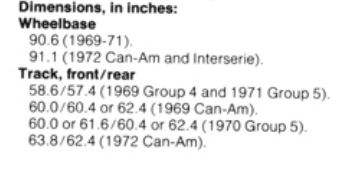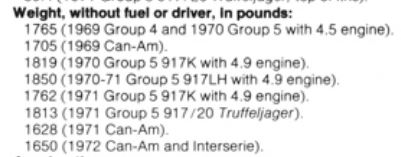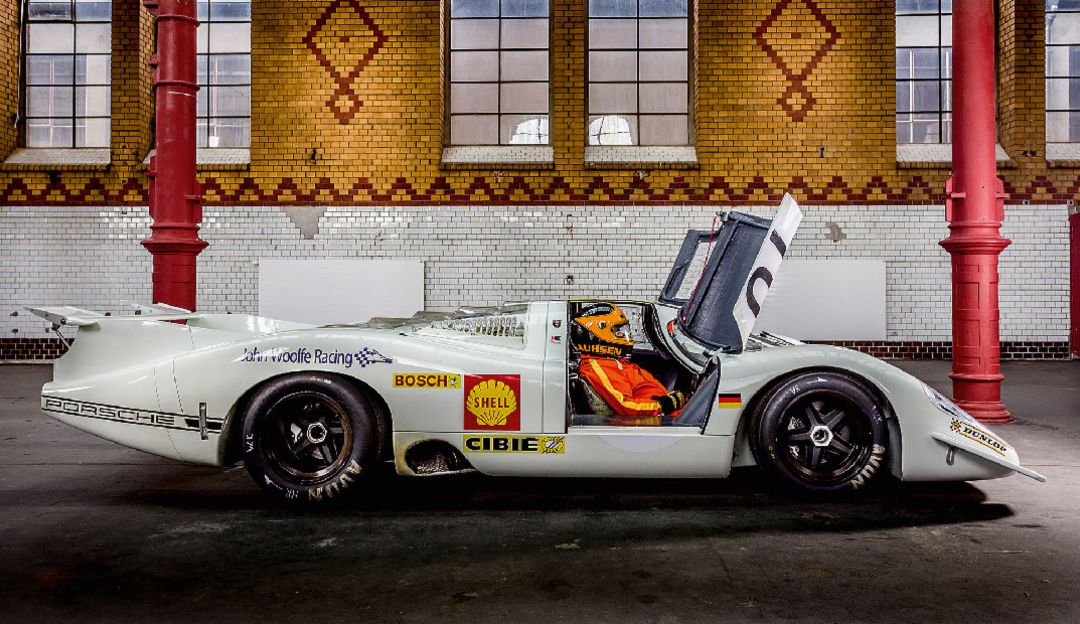Peter Hinsdale's "The Fabulous Porsche 917" lists the following specs, but elsewhere on the internet, I am finding wildly different figures.
Does anyone have the definitive dimensions either from Paul Frere's or Walter Näher's book?



Posted 08 January 2021 - 04:20
Peter Hinsdale's "The Fabulous Porsche 917" lists the following specs, but elsewhere on the internet, I am finding wildly different figures.
Does anyone have the definitive dimensions either from Paul Frere's or Walter Näher's book?


Advertisement
Posted 08 January 2021 - 07:42
Peter Hinsdale's "The Fabulous Porsche 917" lists the following specs, but elsewhere on the internet, I am finding wildly different figures.
Does anyone have the definitive dimensions either from Paul Frere's or Walter Näher's book?
I know very little about these cars. But from those that do virtually no 2 cars were alike. Updates from the factory and on the run and such a range of engine and transaxle specs.
Though to me that wheelbase looks way too short at 91" I would have though around a 100-102. Be bloody twitchy [which they were] at 91"
1628 lbs sounds quite light as well.
Any racecar is a work in progress, things break you fix them better, make the car handle better, make the car better power down, brake upgrades, and pure rotor calliper weight would be different for a 24 hour event V a 24 min one!
Plus ofcourse brake cooling tanks, drivers drink bottle etc way smaller for a sprint race than an enduro.
Ditto for engine components, lightweight stuff and more rpm and boost for a sprint race v enduro
Posted 08 January 2021 - 09:56
I'll take a look in Frère's book later; I've been rearranging some of my books - unsuccessfully it seems - as I can't find it at the moment...
But his chapter on the 917s in Cars in Profile, vol 1 cites the wheelbase for the 917/10 as 2.316m, or 90 5/8".
(917-30 was, of course, longer; that was, after all, one of the primary reasons for building it).
I've never compared the data with Hinsdale's book - but one is never sure who is using what sources, or if one work relies on a another. I've always assumed that Frère's (or Barth's) published data would be as correct as it gets - but who knows?
Edited by 2F-001, 08 January 2021 - 10:08.
Posted 08 January 2021 - 10:18
Porsche homologation for the 917 -FIA number 250 states :-
Wheelbase 2300mm , 90.6inches
Front track 1488mm , 58.5 inches
Rear track 1457 mm , 57.3 inches
Weight 800 kg 1762.1 lbs
If checked any car running to this homologation should comply.
Posted 08 January 2021 - 11:02
Ah! Some kind soul has sent me the data from the PF book
The wheelbase was precisely 2300mm for all cars and track width varied depending on the tyre rims used. The FIA HTP papers are for the 1969 model which only used 12" rims on the rear. By 1971 they were using 17" which widened the track considerably. For the Longtail/Langheck. they ran 10.5 and 15" rims at Le Mans to lessen the drag. Hinsdale's book says the 1969 front/rear track widths are the same as those in '71. That never made sense to me.
I understand they ran extremely stiff suspension on these due to the rearward weight bias of 63.5%, and with the short wheelbase they had to setup their car to understeer, else it was quite a handful. Does anyone have any of the official setup data for spring rates, etc.?

Regarding weight, all 917s were underweight, Large oil tanks were added to bring it up to the minimum regulations of 800kg. The Langheck cars had to run with spare tyres and two batteries so weighed about 25kg more. The official quoted figure I found elsewhere was 823kg. The John Wyer prepared cars were about 25-30kg more than the factory cars, so around 830kg. Maybe because the factory could build frames from magnesium while JW had to use aluminium?

Edited by Paul Taylor, 08 January 2021 - 12:12.
Posted 08 January 2021 - 13:26
There was a thread some years back where it was shown that most Porsche prototypes up to and including the 936 had the same wheel base of 90-91 inches. The 936 of course was said to have used 917 frames.
Posted 08 January 2021 - 14:45
From the Lothar Boschen/Jurgen Barth book published 1977 - not sure if this is the same as the PF book mentioned above, anyway here it is

Posted 09 January 2021 - 01:01
Ah! Some kind soul has sent me the data from the PF book
The wheelbase was precisely 2300mm for all cars and track width varied depending on the tyre rims used. The FIA HTP papers are for the 1969 model which only used 12" rims on the rear. By 1971 they were using 17" which widened the track considerably. For the Longtail/Langheck. they ran 10.5 and 15" rims at Le Mans to lessen the drag. Hinsdale's book says the 1969 front/rear track widths are the same as those in '71. That never made sense to me.
I understand they ran extremely stiff suspension on these due to the rearward weight bias of 63.5%, and with the short wheelbase they had to setup their car to understeer, else it was quite a handful. Does anyone have any of the official setup data for spring rates, etc.?
Regarding weight, all 917s were underweight, Large oil tanks were added to bring it up to the minimum regulations of 800kg. The Langheck cars had to run with spare tyres and two batteries so weighed about 25kg more. The official quoted figure I found elsewhere was 823kg. The John Wyer prepared cars were about 25-30kg more than the factory cars, so around 830kg. Maybe because the factory could build frames from magnesium while JW had to use aluminium?
15 kilos lighter with a magnesium frame would not have been worth the extra cost. Or safety issues as well.
16 kilos heavier for a turbo engine?? Considering the turbo/s itself would be most of that weight let alone all the plumbing and intercoolers
And the track with a 12" rim will never be the same as a 17" rim.
So dodgey figures and specs!
91" [or so] is still very short. A GTV Alfa or Mk2 Escort are very short at around 94"
My XU1 Torana Sports Sedan was 99-100" according to specs. I know in the end with a lot more caster and rear suspension mods it was closer to 103" And that was simply evolution. The front caster was at least half of that.
Posted 09 January 2021 - 06:12
Posted 09 January 2021 - 06:31
15 kilos lighter with a magnesium frame would not have been worth the extra cost. Or safety issues as well.
16 kilos heavier for a turbo engine?? Considering the turbo/s itself would be most of that weight let alone all the plumbing and intercoolers
And the track with a 12" rim will never be the same as a 17" rim.
So dodgey figures and specs!
91" [or so] is still very short. A GTV Alfa or Mk2 Escort are very short at around 94"
My XU1 Torana Sports Sedan was 99-100" according to specs. I know in the end with a lot more caster and rear suspension mods it was closer to 103" And that was simply evolution. The front caster was at least half of that.
The wheelbase is about 3cm longer than a late-90s Mazda MX-5 and 10cm-20cm wider track depending on the wheels used. It seems pretty reasonable.
I am not sure why Porsche went to the trouble of creating a magnesium frame when the car already met the weight limit. For every one frame they made, apparently they had to throw several others in the bin because they were so hard to make.
Anyway, here's a great (modern) shot of Willi Kauhsen sitting in his 917. You can see how much of the car was taken up by the engine, the driver is practically sitting on top of the front axle:

Posted 09 January 2021 - 08:30
In the flesh they are surprisingly compact - maybe their fearsome reputation makes us want to see something bigger? But compared to a 907 ...Jeez ...I saw my first (50 odd years after seeing my first picture of one) only two years ago at Goodwood and it was tiny .
Posted 09 January 2021 - 15:59
Paul - the pics/scans that someone has sent you are from the Cars in Profile book (originally published as separate pamphlets for each car), not Frère's more exhaustive Porsche racing cars of the 70s (the book I have temporarily mislaid), which has lots of data more like the Barth book mentioned above.
Out of interest I'll check in the other Frère book when I find it - but I'd be surprised if the Barth book is not correct and I'd expect the two to match. And yes - none of these machines are anything like as big as some folks imagine!
Edited by 2F-001, 09 January 2021 - 16:00.
Posted 09 January 2021 - 18:36
I don't know if it's helpful but Hans Mezger apparently read a paper on the development of the 917 at an IMechE meeting in Birmingham on 4th January, 1972, subsequently abridged by my father for the 19th January issue of "The Motor".
Posted 10 January 2021 - 12:39
I have the Frere book mentioned, will try to post relevant page

Edited by Glengavel, 10 January 2021 - 12:54.
Posted 11 January 2021 - 12:48
In the flesh they are surprisingly compact - maybe their fearsome reputation makes us want to see something bigger?
Something I've always privately thought....I've often wondered if it's almost a motorsport optical illusion ? Watching Rodriguez splashing around Brands in 1970, we all marvelled at his ability to manhandle such a 'big beast' around the track's twisty environs.
But when I stood next to one of the Martini cars at the 1971 race, I couldn't get over how small it seemed.
Posted 11 January 2021 - 14:40
Most sportsracers of the 917 era were quite small by todays vast standards.
The " normal" wheelbase for many 1960's racers was about 90 inches and seldom above 100 inches.
Tyres were obviously narrower until CanAm etc so cars were narrow.
With no ground effects a large plan area to generate downforce was of no benefit so overhangs were short except at Le Mans.
The 7 litre Chapparal's also had a 90 inch size wheelbase despite 600 bhp .
As wings came in the importance of a stable ride height grew to keep wing angles steady and the much grippier tyres led to more weight transfer which encouraged a longer wheelbase to avoid high fore and aft weight transfer under braking then acceleration.
Also Porsche were always very conservative on chassis design and lked to stay with what they knew hence teh similarity of the 908 and 917.
Posted 12 January 2021 - 10:11
I have the Frere book mentioned, will try to post relevant page
That's awesome, thank you! But also incredibly frustrating to see Paul contradict his own data in Cars In Profile. I haven't yet seen a single photo or drawing of a 917 with the front track wider than the rear and now I have no idea what to trust.
Posted 13 January 2021 - 09:32
"The Racing Porsches" by Paul Frere has some figures on the lateral g that the cars could do:
https://books.google...i063BQlg&edge=0
However I think these could be for the Porsche 910. not the 917. If anyone has this book, it would be useful to know what kind of g-forces/laptimes they were getting at Weissach.
Posted 16 January 2021 - 07:39
Right, someone, somewhere on the internet, took a picture of Paul Frere's "Racing Porsches" and put it on the internet, which gives us the lateral acceleration figures of the later 917 (after they fixed the aero problems and moved up to bigger tyres).
Times taken on the Weissach skid pad (95m radius corner, along the inside edge)
Dunlop CR82
Front 11.6", Rear 15" - 17.72 sec ; 1.233g
Front 11.6", Rear 13.6" - 17.92 ; 1.210g [Note: Same tyres as a 1968 Matra MS9]
Firestone R125
Front 10.2", Rear 12.2" - 17.82 ; 1.221g
Goodyear Blue Streak
Front 10.5", Rear 15.5" - 18.14 ; 1.179g
Bridgestone RA 13
Front 12", Rear 14" - 19.1s ; 1.08g
Later they increased the caster from 1 degree to 5 degrees, which gave unacceptable steering forces but 1.245g and then they increased the camber front and rear to -1.45 / 1.30 deg and gained a small chunk more at 1.258g. These kinds of cambers could never be run in a race because the tyre shoulders would wear down to nothing in a very short time (they ran with practically 0 degrees of camber at Le Mans for stability and tyre life).
Hope this helps someone in the near or distant future.